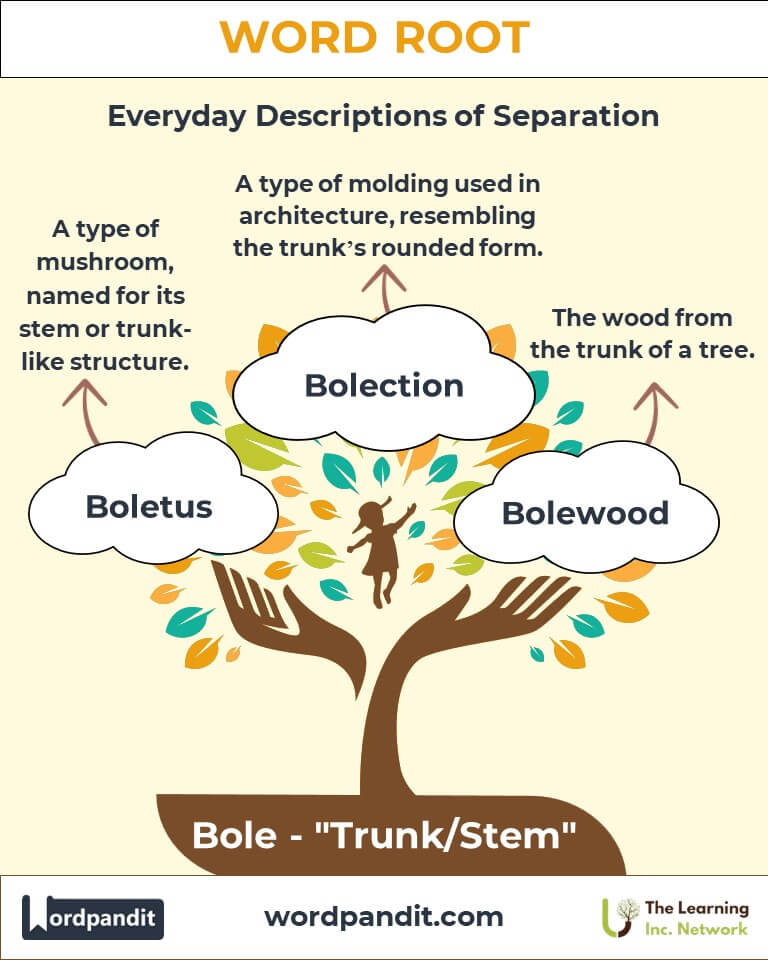Bole: The Art and Science of Growth and Trunk-Based Terms
Discover the linguistic and cultural significance of the word root Bole. Derived from ancient languages, this root forms the basis of terms that connect us to trees, growth, and their centrality in ecosystems and human culture.

Table of Contents
- Introduction: The Root of Growth and Vitality
- Etymology and Historical Journey
- Mnemonic: Unlocking the Power of Bole
- Common Bole-Related Terms
- Bole Through Time
- Bole in Specialized Fields
- Illustrative Story: Bole in Action
- Cultural Significance of the Bole Root
- The Bole Family Tree
- FAQs About the Bole Word Root
- Test Your Knowledge: Bole Word Root Quiz
- Conclusion: The Living Legacy of Bole
Introduction: The Root of Growth and Vitality
What connects the sturdy trunk of a tree to vibrant human progress? The word root Bole traces its origins to Greek and Latin, denoting "trunk" or "body." Pronounced as "bohl," this root embodies themes of growth, stability, and centrality, forming the basis for words related to trees, biology, and even art. By exploring Bole, we uncover its relevance in natural science, language, and culture.

Etymology and Historical Journey
The root Bole originates from the Greek bolos, meaning "lump" or "clod," and Latin bolus, referring to "a mass" or "trunk of a tree." Over time, Bole evolved to signify the main stem or core of an entity, extending to biology and anatomy to describe central or structural parts. The word traveled through Old French into Middle English, gaining nuanced meanings across disciplines.
Mnemonic: Unlocking the Power of Bole
Mnemonic Device: “Imagine a tree’s bole standing tall and firm as the ‘body’ supporting branches and life.”
This visualization connects the root's meaning to its literal and figurative interpretations, reminding you that Bole centers around structure and stability.
Common Bole-Related Terms
- Bole (bohl): The trunk of a tree.
Example: "The thick bole of the ancient oak was a testament to its age." - Bolero (boh-leh-roh): A short jacket, often cropped, named for its structural simplicity.
Example: "She wore a bolero over her dress for the evening event." - Boleslaw (boh-leh-slahv): A Slavic name meaning "great glory," rooted in themes of strength.
Historical Note: Worn by several medieval kings, signifying power. - Bolus (boh-luhs): A rounded mass, often used in medical contexts to describe food or medication.
Example: "The nurse administered a bolus injection to provide rapid relief." - Bolide (boh-lide): A large meteor that explodes in the atmosphere.
Example: "The blazing bolide lit up the night sky."
Bole Through Time
- Ancient Foundations: Initially associated with tree trunks, Bole became a metaphor for central structures in human and ecological systems.
- Modern Extensions: Words like bolus evolved in medical terminology, emphasizing the root’s application to cohesive masses or units, whether in anatomy or pharmacology.
Bole in Specialized Fields
- Medicine:
- Bolus: A concentrated dose of medication given intravenously.
- Importance: Essential in emergencies like diabetic shock or severe infections.
- Astronomy:
- Bolide: Exploding meteors are significant for studying cosmic events.
- Application: Tracking bolides helps scientists understand planetary defense mechanisms.
- Art:
- Bole Clay: A fine, reddish clay used as a base for gold leaf gilding.
- Historical Use: Widely employed in Renaissance artwork for its adhesive qualities.
Illustrative Story: Bole in Action
Dr. Elena, a seasoned astronomer, tracked an unusual object in Earth’s orbit. As it approached, the object—a bolide—threatened to fragment dangerously near populated areas. Using advanced spectrometry, Elena calculated its trajectory and broke it apart safely in the upper atmosphere. Her knowledge of Bole-related terms like bolide was key to decoding the celestial threat. This triumph showcased the word’s relevance in saving lives through science.
Cultural Significance of the Bole Root
From Slavic names like Boleslaw to its symbolism in literature, Bole reflects strength and centrality. Trees, with their trunks as boles, hold mythological significance worldwide—representing life, growth, and connectivity.

The Bole Family Tree
- Root: Arbor (Latin): Related to trees.
- Arborist: A tree specialist.
- Root: Truncus (Latin): Related to the trunk or core.
- Truncate: To shorten by cutting off.
- Root: Corpus (Latin): Refers to the body.
- Corpulent: Describing a large body.
FAQs About the Bole Word Root
Q: What does "Bole" mean in its simplest form?
A: Bole primarily refers to the trunk of a tree—the central, supporting structure. This definition connects metaphorically to strength, stability, and growth in both natural and abstract contexts.
Q: How is "Bolus" used in medical and non-medical contexts?
A: In medicine, a bolus is a concentrated dose of medication administered rapidly, often intravenously, to address urgent conditions. Outside of medicine, it describes a rounded mass of something, such as chewed food before swallowing.
Q: What makes "Bole Clay" important in art?
A: Bole clay, often red or yellow, is used as a base for applying gold leaf in gilding. Its adhesive properties and warm undertones enhance the gold’s luster, making it essential in decorative arts and historical artworks.
Q: What is the significance of "Bolide" in astronomy?
A: A bolide is a large meteor that explodes upon entering the Earth’s atmosphere, often creating a bright flash and sometimes a sonic boom. Scientists study bolides to understand celestial mechanics and potential planetary threats.
Q: Are "Bole" and "Bolero" connected linguistically?
A: Yes, they share a thematic link through their structural implications. While bole refers to the trunk, bolero (a short jacket) denotes a structural simplicity, emphasizing function over embellishment.
Q: What does "Boleslaw" mean, and where is it used?
A: Derived from Slavic roots, Boleslaw means “great glory” and symbolizes strength and leadership. It is a common name in Eastern Europe, especially among royalty and historical figures.
Q: How does the root "Bole" relate to biology?
A: In biology, bole is used to describe the main trunk of a tree, which transports nutrients and provides support, much like a central system in other organisms.
Q: What are some metaphorical uses of "Bole"?
A: Metaphorically, bole is used to describe the "core" or "central structure" of ideas, organizations, or systems, emphasizing its foundational role.
Test Your Knowledge: Bole Word Root Quiz
1. What does the root "Bole" mean?
2. What is a "Bolus" in medicine?
3. Which term describes an exploding meteor?
4. What is "Bole Clay" used for?
5. Which field uses "Bole" metaphorically for "trunk"?

Conclusion: The Living Legacy of Bole
The Bole root weaves a fascinating narrative of centrality and growth, bridging the natural, linguistic, and cultural worlds. From tree trunks to celestial events, its applications highlight humanity’s deep-rooted connections to stability and resilience. As science and language evolve, so will the enduring legacy of Bole.











